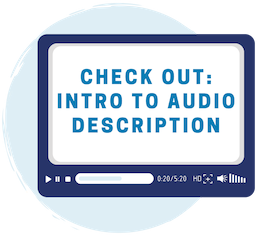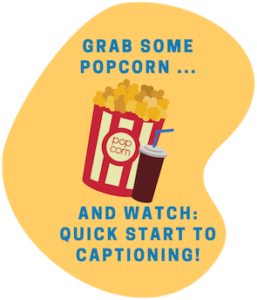3 Secrets to Creating Better Video
Updated: August 23, 2024
It’s predicted that 82% of the world’s internet traffic will be video by 2020. If you’re publishing video content for training, marketing, or other purposes, that’s a great first step to keeping up with the trends. But, with that much content, you have a lot of competition when it comes to getting viewers and engagement to your video content. In this article, we’ll tell you how to create better video content, and what the research says about how this can increase Search Engine Optimization (SEO), better the user experience, provide accessibility, enhance learning, and meet the legal requirements.
How to Create Accessible Video
Before we go any further, it’s crucial to first understand what we mean when we say “accessible video.” (We mention it a lot!) The University of Washington describes, “An accessible video includes captions, a transcript, and audio description and is delivered in an accessible media player.” We’ll explore each of these elements below.
 Closed Captions
Closed Captions
Captions are time-synchronized text that can be read while watching a video. When captions are available on a video it’s usually noted with a CC icon. Captions assume the viewer can’t hear, so they include relevant non-speech elements like sound effects and speaker identifications to make it easier for the viewer to understand what is going on.
Transcripts

Interactive Transcript
At 3Play we offer a unique spin to transcripts through our Interactive Transcript Video Search function. These features allow you to type in a search term to see every location where that word is spoken in your video. By clicking on one of the instances of your search term, you’ll jump directly to that point in your video!
Audio Description

Audio description is an accommodation for blind and low vision individuals and is meant to provide information on those visual components that are essential to the comprehension of the program.
The description of media involves the interspersion of audio description snippets within the program’s original audio components. This is to allow the individual the benefit of the description, without sacrificing the information in the existing content.
One major challenge with audio description is that it’s extremely hard to publish. The best way to get around this? 3Play’s Plugin! With our free plugin, you can simply copy and paste an embed code underneath your video to toggle on or off the audio description. Seriously, it’s that simple! (Watch our Intro to Audio Description webinar to learn more!)
Wondering why we’re telling you all about accessible video? We’re getting there!
Try out the 3Play Plugin:
Create Better Video
The secret to creating better video is to create accessible video. There are a number of reasons that accessible video is better video. Below we dissect a number of those reasons.
Search Engine Optimization
Since video content is not text-based, it’s important to provide an alternative way to inform Google what your video is about so that it can rank in searches. Transcripts and captions allow Google to crawl everything that is said in your video, increasing not only your keyword density but also your keyword diversity. This allows your video to rank for a multitude of relevant terms, instead of just the prioritized terms in your video description, title, and tags. In a recent study, it was found that Facebook video posts with captions received 135% greater organic reach. Adding transcripts and captions to your videos is a proven strategy for improving SEO, views, engagement, and search rank.
User Experience
80% of viewers react negatively to videos autoplaying with sound, so many social sites play them silently. However, 41% of videos are incomprehensible without sound or captions. Simply put, adding captions to videos makes for a better experience – after all, what good is a video that’s incomprehensible?
Captions aren’t the only tool that makes for better user experience. Interactive transcripts make your video content vastly searchable – a particularly valuable tool in the classroom. The interactive transcript lets viewers search for keywords within the transcript and see everywhere the keyword appears. They can even jump to any spot in the video by clicking on the specific keyword. In a study conducted by MIT OpenCourseWare, 97% of students said interactive transcripts enhanced their learning experience.
Like captions and transcripts, the benefits of audio description also improve user experience in a number of ways. Audio description provides a lot of flexibility to view videos in eyes-free environments. It helps allows viewers to understand the visuals that are taking place on screen without being tied down in one place. A trend has developed where people are actually listening to movies with audio description turned on, and using them as an audiobook to listen while driving, cooking, or doing other chores around the house.
“AD mode is awesome, and I like to call it chore mode, since I can listen to stuff while doing chores and not have to look at the screen.” – Reddit User
Accessibility
71% of people with a disability leave a website immediately if it’s not accessible. Captions provide accessibility to deaf and hard of hearing individuals, and audio description provides accessibility to those who are blind or low vision. In addition, these tools can help individuals who have learning disabilities or are on the autistic spectrum. For example, many individuals who have trouble processing like to read along with audio content – either with time-based captions or an interactive transcript. Making content accessible means considering all different types of needs, and providing what you can to meet those needs.
Learning
80% of people who use captions aren’t deaf or hard of hearing. So who are they? Many are students! Captions help with comprehension of dialogue, clarification of terms, concentration, and engagement. In a research study on student uses and perceptions of captions and transcripts, 98.6% of students reported finding captions helpful. 71% of students without hearing difficulties said they use captions at least some of the time. A few of the reasons students are using captions is to help with focus, help retain information, understand professors with heavy accents, and be able to watch videos in sound-sensitive environments.
Students also reported using transcripts. The most common use of transcripts was for study guides, as students can easily repurpose the written text. Interactive transcripts are also particularly helpful for following along with a lecture or going back to specific topics or keywords for review.
Audio description is helpful for learners as well. Listening is a key step in learning a language and associating it with appropriate actions and behaviors. Auditory learners can greatly benefit from audio description as well. Research into how the brain processes information reveals that there are two channels – auditory and visual. It’s estimated that about 20-30% of students retain information best through sound.
Legal compliance
Captions and audio description are required under a number of US accessibility laws as well as state and local laws.
The Americans with Disabilities Act is a broad anti-discrimination law that is meant to provide protection for people with disabilities in the public sector. Because of its broad reach and interpretation, the ADA applies not only to many types of organizations. Although it doesn’t mention captions or audio description by name, both Title II and III of the ADA require auxiliary aids for people with disabilities.
Section 504 and Section 508 of The Rehabilitation Act also apply to video accessibility. Section 504 directly applies to federal programs and programs that receive federal funding; Section 508 only applies to federal programs. Section 508 specifically references standards from Web Content Accessibility Guidelines 2.0 (WCAG 2.0) which include requirements for captioning and audio description.
The 21st Century Communications and Video Accessibility Act (CVAA) also applies to video. When it comes to captions, the CVAA only requires that online video which previously appeared on television with captions be captioned when posted online. The CVAA is currently phasing in audio description requirements for broadcast TV.
If you want help figuring out which captioning laws apply to you, take our short quiz!
Accessible Video Is Better Video
If you’re still not convinced that accessible video is in fact better video, take a moment to think about your day-to-day. How do you start your morning? If you start by checking your phone (and likely watching video content) you’re not alone. A 2017 survey from ReportLinker, found that 46% of Americans check their smartphones before they even get out of bed in the morning.
If you have a roommate, partner, or children still sleeping nearby, you’ll want to make sure those videos are playing silently. If they have captions you can still tell what’s going on. Hence, better video!
Once you finally put down the phone and get ready to head out to get to work, you may have a long commute ahead. Whether you take public transportation, walk, bike, or even drive, those 45 minutes are precious. If you’re on the train, captions can allow you to watch a video without disturbing those around you. If you’re walking, biking, or even driving, you might play a video with the audio description as if it were an audiobook. These are just a few examples of how accessible video is better video – for everyone, whether you realize it or not.
—
Together, we can create content that’s not just accessible, but better! Get started today.



 Closed Captions
Closed Captions






